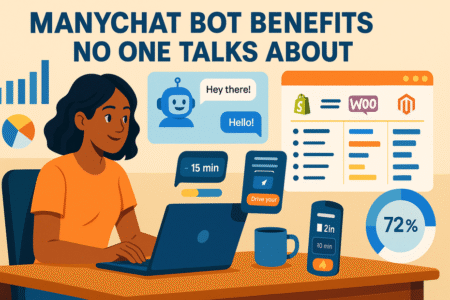Table of Contents
In the expansive realm of the digital age, content reigns supreme. With every click, scroll, or tap, users are constantly engaging with various forms of content, be it a blog post, a video, a podcast, or even a simple tweet.
Such content isn’t just about entertainment; it’s the new currency for businesses, creators, and brands. A well-crafted article or a gripping video can influence purchasing decisions, shape opinions, and even instigate societal change.
Understanding Content Monetization
Beyond its vast influence, content also offers individuals an unmatched platform to turn their passions into tangible profits. Whether it’s a hobbyist baker sharing unique recipes or a musician uploading original tracks, the digital sphere provides endless avenues to monetize content.
For the passionate and persistent, this means not only an opportunity to share what they love but also to carve out sustainable income sources from it.
What does it mean to monetize content?
At its core, to monetize content is to extract financial value from the content you produce. But beyond this simplistic definition, the concept of content monetization holds immense significance in the modern world.
Digital content, whether it’s a YouTube video, a blog, or even an Instagram post, has the potential to reach millions, if not billions. When such content gains traction, it naturally attracts the attention of businesses, advertisers, and audiences willing to spend money.
Monetizing content could involve direct methods like selling a product or service or indirect ones such as displaying ads or securing sponsorships. In an era where traditional jobs are being juxtaposed against the rise of the gig economy, the ability to monetize content provides a dynamic, flexible, and scalable way to generate income.
Why should you consider monetizing your content?
Stepping into the realm of content monetization is more than just about making money. First and foremost, it provides creators with the financial gains necessary to sustain and upscale their content creation process. Funding can aid in improving equipment, expanding reach, or even hiring help.
But beyond monetary benefits, monetizing content can serve as validation of one’s work. Achieving recognition, attracting collaborations, or garnering a loyal audience base can significantly boost a creator’s morale and drive. Such recognition often snowballs into broader opportunities, from speaking engagements to book deals or even launching a dedicated brand.
Popular Methods to Monetize Content
In the constantly evolving digital landscape, creators have myriad avenues to monetize content. As online platforms continue to grow, these monetization strategies become more diverse, offering opportunities regardless of your content type or audience size.
While the prospect might seem daunting, understanding and leveraging these methods can convert your digital presence into a viable revenue stream. Here’s a closer look at some of the most prevalent ways creators are cashing in on their content.
Ad Revenue
Perhaps the most straightforward method to monetize content is through ad revenue. When your content garners sufficient traffic or views, advertisers are willing to pay for a slice of that attention. Platforms like Google AdSense have made it relatively easy for content creators, even with modest audiences, to earn from ads.
Pay-per-click (PPC) and Cost per mille (CPM) are common models in this space. With PPC, you earn every time a user clicks on the ad displayed on your platform, while CPM pays out per thousand views.
The trick to maximizing ad revenue isn’t just about increasing traffic but ensuring your audience is engaged and relevant to the advertisers. This often requires a balance; too many ads can deter users, but too few might mean missed revenue opportunities.
Affiliate Marketing
Affiliate marketing is a lucrative avenue for those looking to monetize content without creating a product. Essentially, you promote someone else’s product or service on your platform. Every time a purchase is made through your referral, you earn a commission. Sites like ShareASale have popularized this method, offering a vast range of products to promote.
For affiliate marketing to be effective, authenticity is crucial. Promoting products that resonate with your content and are genuinely beneficial to your audience can lead to higher conversion rates. It’s not just about plastering affiliate links but providing real value, perhaps through in-depth reviews or how-to guides.
Sponsored Content
As you build authority in your niche, brands may approach you to create content specifically promoting their products or services. Sponsored content can come in various forms – blog posts, videos, social media posts, or podcasts. It’s a collaboration where both the brand and the creator benefit.
However, transparency is paramount. Your audience trusts you, and it’s essential to disclose when content is sponsored. While it’s tempting to accept every offer, partnering with brands that align with your values and audience’s interests will ensure long-term success and trust.
Selling Digital Products
For those with expertise in a particular area, selling digital products can be a gold mine. Think e-books, online courses, templates, or even exclusive content available for a fee. Unlike physical goods, digital products don’t require storage or shipping, making them incredibly scalable.
Platforms like Udacity and Udemy can assist creators in selling these products. Remember, the key here is quality. Your digital product should offer substantial value, helping users solve a problem or achieve a goal.
Subscription Models and Memberships
One of the rapidly rising methods to monetize content is through subscription models and memberships. Websites like Patreon and Substack have popularized this approach, enabling creators to offer exclusive content to subscribers or members who pay a monthly fee.
This could be behind-the-scenes content, early access to new releases, special newsletters, or any other premium material that isn’t available to the general audience.
Such models not only provide a consistent revenue stream but also help foster a dedicated community. These loyal subscribers or members are often a creator’s biggest advocates, promoting the content organically and providing constructive feedback.
However, it’s essential to ensure that the premium content is genuinely worth the subscription fee. Consistently delivering high-quality, unique content can keep subscribers engaged and reduce churn rates.
Licensing and Syndication
If your content has a broader appeal, especially in sectors like photography, music, or videography, then licensing can be a profitable route. By allowing other entities to use your content for their purposes (be it for advertising, educational content, or any other commercial use), you can charge a licensing fee.
Syndication is another related approach where you allow other platforms or publications to republish your content. This not only earns you a fee but also widens your reach to new audiences. It’s especially popular among bloggers and news content creators.
Merchandising
For those who have successfully built a strong brand or community around their content, selling merchandise can be an effective monetization method. This could range from branded apparel, posters, stickers, to any other tangible goods.
Websites like Teespring or Merch by Amazon simplify the process, handling the production, shipping, and customer service, allowing creators to focus on design and promotion.
While merchandising might not be suitable for every content creator, those with a dedicated fan base can find it a fun and interactive way to monetize content while strengthening their brand identity.
Monetizing Specific Content Types
In the digital realm, content creation is no longer limited to written articles. Various content forms, from podcasts to infographics, offer creators a myriad of avenues to reach and engage their audience.
However, each content type presents unique opportunities and challenges when it comes to monetization. Here’s a thorough examination of how you can monetize specific content types to their full potential.
Blogs and Written Content
Written content, especially blogs, has been the bedrock of the internet since its inception. But as the web becomes inundated with articles, standing out and monetizing effectively requires strategy. Subscription models have gained traction, with platforms like Medium offering partner programs where writers earn based on engagement.
Another approach is the “freemium” model, where basic content is free, but in-depth guides or exclusive articles are behind a paywall. Additionally, affiliate marketing, as mentioned earlier, works exceptionally well with blogs.
By integrating product links naturally within articles or reviews, bloggers can earn a commission on sales, ensuring they monetize content without compromising its integrity.
Videos and Visual Content
The meteoric rise of platforms like YouTube has made video content a lucrative medium. To monetize content effectively in this realm, creators often rely on ad revenues through platforms’ partner programs. However, diversifying is key.
Selling premium courses, leveraging Patreon for exclusive video content, or collaborating with brands for sponsored videos can significantly boost earnings. Additionally, licensing video content, especially stock footage, can be a gold mine for videographers.
Podcasts and Audio Content
With the podcasting industry booming, there’s never been a better time to monetize audio content. Ad spots, especially those read by the host, are highly effective given the intimate nature of the medium. Affiliate promotions can also be integrated seamlessly into episodes, offering listeners special deals.
Beyond advertisements, a powerful method to monetize content in podcasting is listener support. Platforms like Anchor facilitate listener donations, while Patreon-style models, offering exclusive episodes or early access, can further enhance revenue streams.
Social Media and Influencer Content
Social media platforms, from Instagram to TikTok, offer influencers a plethora of ways to monetize content. Sponsored posts, where brands pay creators to feature their products or services, are ubiquitous. But there’s more to social media monetization. Affiliate marketing, especially with swipe-up links in stories, can be lucrative.
Additionally, selling digital products, like e-books or course access, can be promoted effectively via social media. For influencers with a niche following, launching branded merchandise can also be a game-changer.
Photography and Visual Art
The age of digital media has propelled visual artists and photographers into a realm of vast monetization possibilities. Stock photography sites like Shutterstock and Getty Images allow photographers to sell their images, earning every time someone purchases a license to use them.
Moreover, platforms like 500px have emerged, focusing not just on stock imagery but on the art of photography, enabling creators to earn from premium licensing and brand partnerships.
For visual artists, websites like Redbubble and Society6 allow them to turn their art into prints, apparel, and various merchandise, earning a cut for each sale. Beyond this, artists can also offer commissioned work, leveraging platforms like ArtStation or even social media to attract potential clients. Digital artists also have the unique opportunity to sell digital assets, brushes, and templates to other creators.
E-books and Self-Published Works
The rise of self-publishing has democratized the world of literature, allowing authors to bypass traditional gatekeepers and reach readers directly. To monetize content in this sphere, platforms like Amazon Kindle Direct Publishing (KDP) or Smashwords are invaluable.
They provide the infrastructure to sell e-books to a global audience. The power here lies in marketing; often, self-published authors leverage blogs, social media, and email marketing to promote their works.
Beyond selling to the public, authors can offer exclusive content, chapters, or books to subscribers on platforms like Patreon or even explore audiobook versions of their writings on Audible or other audio platforms.
Online Courses and Webinars
The e-learning market has witnessed exponential growth, with people seeking knowledge on virtually every conceivable topic. For those with expertise in specific areas, monetizing through online courses can be especially rewarding. Platforms like Udemy, Udacity, and Datacamp allow creators to host and monetize content in the form of structured courses.
Webinars, live or recorded, offer another avenue. These can be particularly effective for business or marketing professionals, consultants, or anyone looking to offer deep dives into niche subjects. Monetizing can be direct, through ticket sales or registrations, or indirect, using webinars as lead magnets for more comprehensive courses or services.
Challenges to Overcome When Trying to Monetize Content
Monetizing digital content might seem like a lucrative venture, but it’s not without its hurdles. The journey from creation to cashing in is paved with challenges that can deter even the most passionate creators.
However, understanding these obstacles can equip you with the strategies to navigate them. Here’s a closer look at the major challenges and how to overcome them.
Saturated Markets and Standing Out
With the vast expanse of the internet, every niche sees an influx of creators trying to monetize content. This saturation can make it challenging to carve a unique space and garner attention.
Solution: Focus on authenticity and quality. Instead of mimicking successful content, find your voice and angle. Dive deep into niche topics, offer unique perspectives, or tap into formats less explored by peers. Moreover, continuous engagement with your audience, be it through comments, emails, or polls, can give insights into what they truly value.
Ad Blockers and Declining Ad Revenues
The widespread use of ad blockers means many visitors never see the ads you display, affecting the potential to monetize content through ad revenue.
Solution: Diversify your revenue streams. Instead of solely relying on ads, explore affiliate marketing, sponsored content, or even selling digital products. Another approach is offering an ad-free experience for a small subscription fee, ensuring steady revenue and enhanced user experience.
Changing Algorithms and Platform Dependencies
Platforms like Google, Facebook, or YouTube frequently update their algorithms. These changes can drastically impact content visibility, affecting creators who’ve heavily invested in a particular platform to monetize content.
Solution: Don’t put all your eggs in one basket. Diversify your online presence across multiple platforms. While it’s essential to stay updated with platform-specific best practices, building a direct relationship with your audience, perhaps through an email list or a personal website, can offer stability amidst changing algorithms.
Trust Issues and Audience Skepticism
With the rise of online scams and low-quality, clickbait content, audiences are often skeptical about monetized content, especially when it comes to affiliate links or sponsored posts.
Solution: Transparency is key. Always disclose sponsored content or affiliate links. Prioritize your audience’s trust over quick gains. Recommend products or services you genuinely believe in, and always prioritize delivering value over monetization. An informed and trusting audience is more likely to engage with monetized content positively.
Oversaturation in the Market
The digital content landscape is a double-edged sword. While the internet has democratized content creation, allowing anyone to publish and potentially monetize content, it has also led to an oversaturated market. Every niche, no matter how specific, has countless creators vying for the audience’s attention.
- Differentiating Your Content from Competitors: To stand out, you need more than just high-quality content. Here are some strategies:
- Identify Unique Angles: Research what’s already out there and find gaps. Addressing unmet needs or giving a fresh perspective on popular topics can set your content apart.
- Invest in Presentation: Whether it’s aesthetically pleasing graphics, interactive elements, or professional editing, polished content can significantly enhance user experience and make your content memorable.
- Engage with Your Community: Respond to comments, hold Q&A sessions, or even co-create content with your audience. This can make your platform more community-centric and interactive, setting you apart from more passive content creators.
Building a Loyal Audience Base
While getting someone to click on your content is an achievement, retaining them is the real challenge. A loyal audience not only provides consistent engagement but can also become advocates for your brand.
- Strategies to Engage and Retain Followers:
- Consistent Posting: Whether it’s a weekly blog post or a daily social media update, consistency builds trust and gives your audience something to look forward to.
- Value-driven Content: Ensure that every piece of content, whether it’s a 2-minute video or a 2000-word article, offers tangible value to the reader or viewer.
- Exclusive Offers: Give your audience incentives to stay. This could be in the form of giveaways, early access to content, discounts, or even shout-outs.
- Seek Feedback and Act on It: Ask your audience what they want to see and make an effort to incorporate their suggestions.
Navigating the Technical Aspects
While creating engaging content is an art, ensuring it reaches the audience involves mastering several technical aspects.
- Platform Algorithms: Each platform, from Google to Instagram, has its algorithm that dictates content visibility. Staying updated with the latest changes and adjusting your strategy is crucial. For instance, if a platform prioritizes video content, consider incorporating more videos into your content strategy.
- SEO: Search Engine Optimization (SEO) is non-negotiable for anyone looking to monetize content, especially written content. This involves keyword research, optimizing meta titles and descriptions, ensuring mobile compatibility, and more.
- Other Technical Hurdles: These can range from website downtimes, issues with payment gateways (for direct sales), to even maintaining website security. Investing in a reliable hosting service, regularly updating your website, and using secure platforms for transactions can mitigate most of these challenges.
Essential Tips for Sustainable Content Monetization
In the rapidly evolving digital realm, the challenge isn’t just to monetize content, but to do so sustainably. This means not only earning consistently but ensuring your monetization strategies don’t alienate or overwhelm your audience. Here are pivotal insights that can guide creators towards long-term profitability.
Prioritize Value Over Monetization
Before thinking about how to monetize content, focus on delivering value. Monetization should be the outcome of the value you provide, not the primary goal.
- Engage with Your Niche: Understand the needs, problems, and desires of your audience. Craft content that answers their questions, inspires them, or offers a fresh perspective.
- Continuous Learning: Stay updated with trends, tools, and insights in your niche. Attend workshops, webinars, or even collaborate with peers to ensure your content remains relevant and valuable.
Diversify Revenue Streams
Just as investors are advised not to put all their money into one stock, content creators should diversify how they monetize content. This ensures stability in income, even if one revenue stream dips.
- Mix and Match Monetization Methods: From ads and affiliate marketing to selling digital products or offering premium subscriptions, explore multiple avenues.
- Test and Iterate: Not every monetization strategy will resonate with your audience. Experiment, gather feedback, and adjust accordingly.
Foster Direct Audience Relationships
Algorithm changes can greatly affect platform-dependent content visibility. However, direct relationships, like those formed through email subscriptions, are more stable.
- Email Marketing: While it might seem old-fashioned, email remains a powerful tool. Offer newsletter exclusives or early-access content to incentivize sign-ups.
- Engage Beyond the Content: Use polls, feedback sessions, or community forums to involve your audience in your content creation process. It not only builds trust but can also provide valuable insights for future content.
Ensure Transparency in Monetized Content
Transparency isn’t just ethical; it’s also good for business. Being open about how you monetize content can foster trust.
- Clear Disclosures: Whether it’s an affiliate link or a sponsored post, always disclose it to your audience.
- Balance Monetized and Non-Monetized Content: Ensure that not every piece of content is monetized. Offer plenty of value without direct monetization to maintain trust and credibility.
Stay Updated with Tech and Trends
The digital landscape is constantly changing. What works today might be obsolete tomorrow.
- Regular Training: Invest in courses that keep you updated with the latest in tech, SEO, and content strategies.
- Join Creator Communities: Engage with fellow creators to exchange tips, insights, and updates on the world of content monetization.
Analyze and Adapt to Audience Behavior
Success in sustainable content monetization doesn’t just rely on the quality of your content but also on understanding and adapting to your audience’s ever-changing behavior.
- Utilize Analytics Tools: Platforms like Google Analytics or in-built social media analytics can provide in-depth insights into how users interact with your content. By understanding which content types or topics resonate most, you can tailor your future content and monetization strategies.
- Seek Direct Feedback: While analytics provide quantitative insights, direct feedback can offer qualitative insights. Regularly run surveys or feedback sessions to understand your audience’s preferences and pain points. This can guide refinements in both content and monetization methods.
Implement Sustainable Pricing Models
If you’re offering premium content, digital products, or services, your pricing model plays a significant role in long-term monetization.
- Value-Based Pricing: Instead of underpricing to attract more users, consider what value you provide and price accordingly. This ensures that you earn what your content is truly worth.
- Offer Tiered Solutions: Not every follower or reader will be willing or able to pay a premium price. Offering tiered solutions or packages can cater to a wider range of audience segments while maximizing revenue.
Regularly Revisit and Revise Monetization Strategies
The world of digital content is dynamic. A strategy that works wonders today might be less effective in a year.
- Set Regular Review Periods: Whether it’s quarterly, bi-annually, or annually, regularly revisit your monetization strategies. Analyze what’s working, what isn’t, and adjust accordingly.
- Stay Informed on Industry Changes: Join industry forums, follow thought leaders, and subscribe to relevant newsletters. This ensures you’re not caught off-guard by shifts in content monetization trends or tools.
Conclusion
As we navigate the vast ocean of the digital realm, it’s evident that while the waves of trends and algorithms are ever-changing, the anchor of genuine value remains consistent. Sustainable content monetization isn’t just a buzzword—it’s a commitment. It’s a promise to prioritize the audience over quick profits, value over virality, and trust over transient trends.
To truly monetize content in a manner that withstands the test of time, creators need to intertwine authenticity with adaptability. The landscape might be crowded, but there’s always room at the top for those who offer unique insights, true value, and an unwavering dedication to their craft and community.
In conclusion, as you embark or continue on your journey to monetize content, remember that it’s not about chasing every new revenue stream or jumping on every trend. Instead, focus on understanding your audience, delivering consistent value, and staying informed. The world of digital content offers boundless opportunities, but the most lucrative rewards will always gravitate towards those who create with passion, integrity, and a genuine desire to enrich their audience’s lives.
May your content not only generate profit but also purpose, paving the way for a legacy that transcends algorithms and endures across digital epochs.








